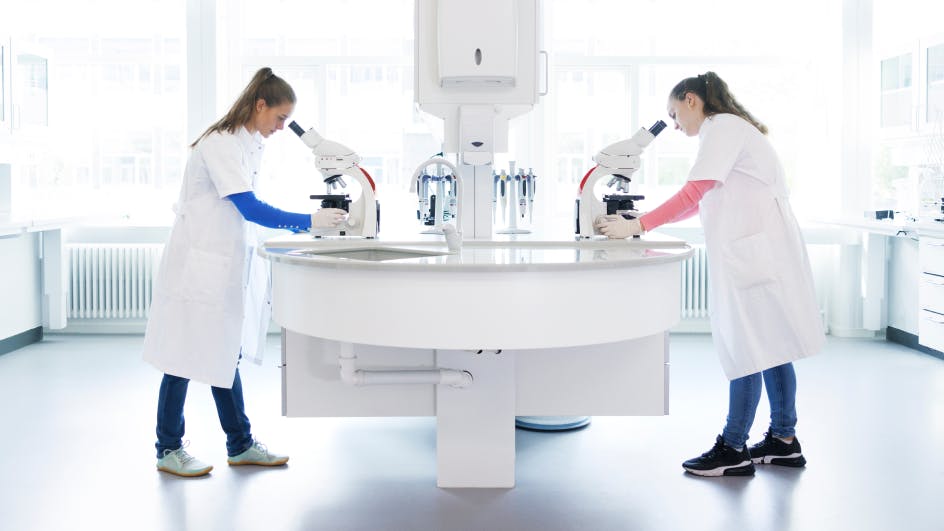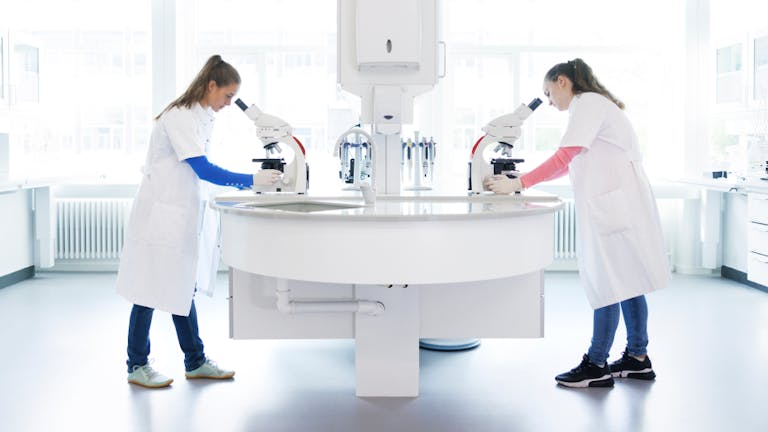The diagnostics industry is in an era of change. Automation, digital pathology, and AI are reshaping the way laboratories operate. These innovations are enabling faster, more accurate results, but they also require new skills and a workforce ready to adapt.
For HR and L&D leaders, this presents both a challenge and an opportunity. The organizations that prepare their workforce today will be the ones that come out on the other side with a lasting competitive edge.
Technology is rewriting diagnostics workflows
Within the diagnostics field, routine tasks like specimen preparation, data entry, and quality control are increasingly being automated, with 89% of laboratory professionals saying their labs need automation to keep up with demand. AI and machine learning are also becoming integral, supporting image analysis, disease detection, and predictive modeling. Studies show AI is already improving histopathology and biomarker analysis in real time.
These shifts extend beyond instrumentation. Digital platforms now require interoperability with electronic health records, but many labs still rely on unconnected systems that force staff to move data manually. At the same time, compliance and security requirements are becoming more complex. New FDA oversight of laboratory-developed tests (LDTs), along with long-standing regulations such as CLIA and HIPAA, mean staff need updated training to keep pace.
Diagnostics is the engine of modern healthcare, with about 70% of medical decisions dependent on lab results. This level of influence makes diagnostic workforce readiness critical for the entire healthcare system.
The impact on frontline lab staff
As automation takes on repetitive tasks, the role of lab professionals is shifting from manual execution to oversight, analysis, and interpretation. The expectation is that automation will allow them to reallocate time to quality control troubleshooting and mentoring newer colleagues.
This transition also heightens demand for data literacy, problem-solving, and troubleshooting skills. Experts note that data interpretation, not just collection, is now essential for laboratory professionals adapting to AI-driven tools. At the same time, uncertainty remains high: more than half of lab professionals say automation threatens their jobs, underscoring the need for clear career pathways and skill-building opportunities.
What diagnostics HR and L&D leaders can do now
To prepare diagnostics teams for the future, leaders can take five critical steps:
- Assess current skills vs. future needs: The first step is understanding where your workforce stands today. Conduct a skills gap analysis across roles like Lab Technicians, Technologists, and Managers. This helps you identify and prioritize which capabilities are strong and which need to evolve.
- Invest in targeted education and upskilling: Once gaps are identified, focus your efforts on building skills in the areas that matter most for your business. Partner with academic institutions or a third-party education solutions provider to deliver industry-relevant programs in AI, data science, regulatory compliance, and advanced lab sciences.
- Integrate digital and durable skills training: Technical fluency alone isn’t always enough. As diagnostics labs grow more tech-enabled, staff also need durable skills such as adaptability, collaboration, and clear communication. Build training programs that combine digital skills with these human capabilities. This ensures teams can interpret complex data, troubleshoot problems, and work effectively together in high-pressure environments.
- Create clear mobility pathways into new roles: Change often creates uncertainty about the future of specific jobs. Address this by mapping out career pathways into emerging roles such as Automation Specialist, Lab Data Analyst, or Compliance Officer. Providing transparency into real career opportunities helps employees see a future with your organization rather than looking elsewhere. This strengthens retention and builds a reliable internal talent pipeline.
- Remove barriers to learning: Even the best programs won’t succeed if employees can’t take advantage of them. Remove financial barriers for employees by covering tuition upfront rather than having them pay tuition then wait for reimbursement. Provide accessible formats such as online and hybrid options so employees can learn without disrupting their work schedules.
The future of diagnostics depends on today’s workforce
Technology isn’t replacing lab professionals, but it is reshaping their roles and the skills required to succeed. By assessing current skills, investing in targeted upskilling, ensuring accessibility, and creating pathways for growth, you can turn disruption into opportunity.
Ready to take action on skill-building for your diagnostics workforce? Download this 3-part talent playbook for practical upskilling strategies you can implement today.

